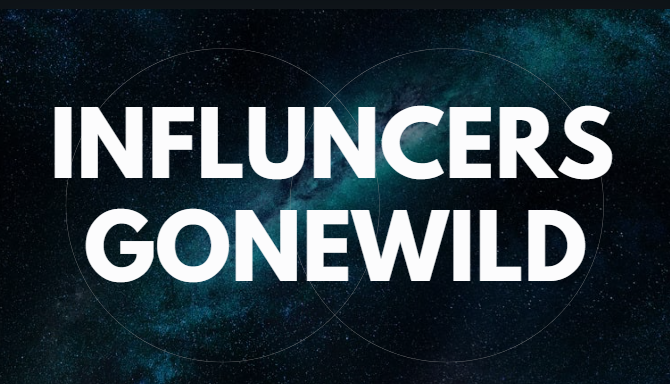Social media has revolutionized fame, turning ordinary people into global influencers overnight. With platforms like Instagram, TikTok, YouTube, and Twitter offering lucrative opportunities, the influencer lifestyle has become a dream for many. However, beneath the curated aesthetics, brand deals, and viral moments lies a troubling reality. The pursuit of online fame has led some influencers to cross ethical, legal, and moral boundaries, giving rise to the phenomenon of “Influencers GoneWild.”
Influencers who want attention at any cost frequently become embroiled in controversy, whether through reckless pranks, financial fraud, public meltdowns, or cultural insensitivity. This article explores the darker side of influencer culture, why it happens, notable scandals, the consequences of unethical behavior, and whether redemption is possible.
Rise of Social Media Influencers GoneWild
Social media influencers have reshaped our digital world, revolutionizing how brands communicate, how we consume news, and even how political messages are delivered. Influencers—whether real or virtual—drive trends by leveraging authenticity, relatability, and creative storytelling on platforms like TikTok, Instagram, and YouTube. This phenomenon has given rise to an entire creator economy, where everyday people and celebrities alike monetize their online presence, often out-earning traditional media outlets in reaching young audiences.
The Influence of the Internet Influencers have tremendous influence over their followers. They shape opinions, influence purchasing decisions, and even impact social and political issues thanks to the eager consumption of their content by millions of followers. The ease with which fame can be gained has resulted in a highly competitive environment in which content creators constantly push the boundaries in order to remain relevant. Monetization and Pressure to Perform
Most influencers rely on sponsorships, brand partnerships, and affiliate marketing for income. Because influencers place engagement ahead of integrity, this dependence can result in unethical decisions. The pressure to generate views and maintain relevance often results in exaggerated content, deceptive marketing, or outright scams.
Types of “Influencers GoneWild” Incidents
There are many types of “Influencers GoneWild” incidents, some of which are written below:
Foolish Stunts and Dangerous Pranks
Many influencers have resorted to risky, irresponsible behavior for viral fame. The distinction between entertainment and criminal activity is frequently blurred by dangerous challenges and staged pranks.
Notable Cases:
A YouTuber pulled a prank on a bank robbery, which caused panic and prompted the police to respond, which led to their arrest. The “Benadryl Challenge” on TikTok, which encouraged excessive antihistamine use, led to hospitalizations and even deaths.
Various influencers have attempted extreme driving stunts, illegal street racing, and parkour challenges, sometimes resulting in serious injuries.
Also Read: Double Entertainment
Fraudulent Activities and Scams
Financial fraud is rampant in the influencer space, where followers’ trust is often exploited for personal gain.
Pump-and-Dump Crypto Scams promote cryptocurrency and NFT projects, convincing followers to invest, only to dump their own holdings for profit, leaving investors with losses.
Fake Giveaways: Promising luxury items like cars and cash prizes but never delivering.
Scandals involving drop-shipping involve deceiving customers about the origins and quality of products while simultaneously marketing low-quality goods at high prices. 3. Social Media Meltdowns and Public Feuds
Some influencers struggle to handle criticism and lash out at their audience, competitors, or brands.
Notable Cases:
A beauty influencer lost millions of followers after a public feud with a former friend, revealing the cutthroat nature of the industry.
Multiple influencers have had live-stream breakdowns, angrily responding to critics, only to later issue damage-control apologies.
Some have even filed lawsuits against critics in an attempt to silence negative press, further damaging their reputations.
Influencers GoneWild Relationships Views
Many influencers have fabricated breakups, family feuds, or betrayals just to attract engagement.
Notable Cases:
In order to produce emotional viral content, some influencers stage a breakup with their partners, only to reveal that it was staged. Revenge Exposés: Exposing private conversations and personal details about ex-partners to gain sympathy and attention.
Family vloggers have been accused of exploiting their children by putting them in difficult situations so that they can get their views.
Offensive and Culturally Appropriate Content
A significant backlash has resulted from disrespecting communities, cultures, and traditions for the sake of viral content.
Notable Cases:
Influencers have been “canceled” after racist tweets or offensive videos from their past resurfaced.
Some have worn sacred cultural attire as mere fashion statements, angering specific communities.
Homelessness, disability, or racial stereotypes have been used as entertainment in exploitative “social experiments.”
Influencers GoneWild and Fake Giving
Some influencers have turned charity into a self-serving marketing tool.
Notable Cases:
Charity videos that are staged involve giving money to the homeless on camera and then taking it back off-screen. Disaster Clickbait: Pretending to be on-site at tragedies to gain sympathy and engagement.
Donation Misuse: Raising money under the guise of charity but using the funds for personal expenses.
Why Algorithms Favor Controversy:
More comments and shares are posted on content that is negative or controversial. Content that keeps users engaged for longer periods of time is given priority on platforms. Videos and posts in the style of clickbait are more likely to appear in recommended feeds. This system incentivizes influencers to manufacture drama, participate in online feuds, or exaggerate situations to manipulate engagement metrics.
Consequences of “Influencers GoneWild” as an Influencer
Going wild” as an influencer may seem like the golden ticket to viral fame and unprecedented growth, but beneath the glittering surface lie significant consequences. In their quest for maximum attention and engagement, influencers risk compromising privacy, authenticity, and mental health by pushing personal boundaries. This pursuit of constant virality can lead to burnout, online backlash, and even a loss of long-term credibility—issues that not only affect professional opportunities but also take a toll on personal lives.
Loss of Sponsorships Brands Influencers GoneWild
Influencers who engage in unethical behavior often lose lucrative brand partnerships, significantly affecting their income.
Legal Repercussions
Some influencer activities cross legal lines, resulting in fines, lawsuits, or even jail time.
Examples:
YouTubers arrested for trespassing while filming content.
TikTok stars sued for promoting scam investments.
Influencers fined for misleading advertising practices.
The Dark Side of Influencers GoneWild Relationships
While brand sponsorships provide lucrative income, they also create ethical dilemmas. Influencers are often pressured to promote products they don’t believe in or conceal negative reviews.
The Impact on Younger Audiences
Teens and young adults make up a significant portion of influencer audiences, which makes them especially susceptible to content that is misleading. Harmful Effects on Young Viewers:
Unrealistic Beauty Standards Influencers GoneWild
Filters and cosmetic procedures create impossible ideals.
Materialism & Overspending
Influencer culture promotes excessive consumerism, often encouraging viewers to buy unnecessary products.
Risky Trends & Challenges
Young audiences are more likely to participate in dangerous stunts and viral challenges.
Parents and educational institutions are becoming increasingly concerned about the influence that social media personalities have on children’s minds. Can scandals help influencers recover? Yes, influencers can recover from scandals, but the road to redemption is often long and challenging. Recovery typically rests on the influencer’s capacity to genuinely apologize, take corrective action, and gradually reestablish trust with their audience. This might involve a transparent public apology, implementing changes to address the underlying issues, and consistently showcasing improved behavior. In the end, while some scandals have the potential to permanently harm an influencer’s reputation, others can also provide an opportunity for rebranding and personal development if managed with authenticity and accountability.
Conclusion:
The rise of “Influencers GoneWild” has reshaped social media, exposing the ethical pitfalls of digital fame. As audiences become more critical, platforms and brands are holding influencers accountable like never before.
Moving forward, successful influencers will be those who prioritize authenticity, responsibility, and ethical engagement. While scandals will always exist, the future of influencing lies in creating content that uplifts communities rather than exploits them.

